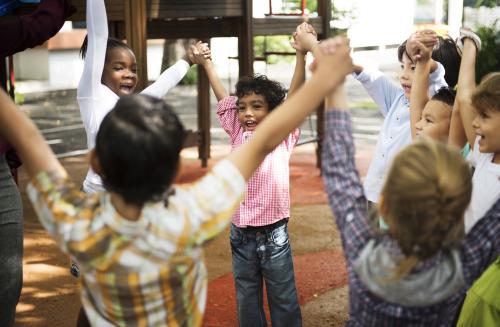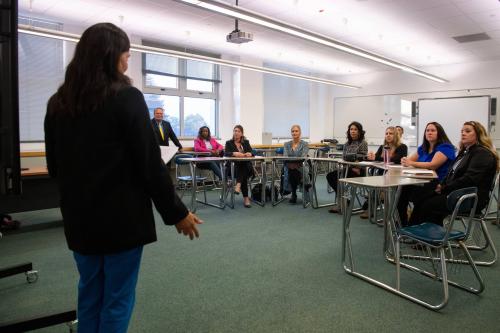This post is part of the “Community Schools Leader Insights” series in which Brookings is sharing the experiences of people in the thick of community schools and who are making strides toward student success through the unique strengths of the local community.
The importance of community schools in Appalachia today
Schools are often the heart of a community, and in rural Appalachia, community schools are a center of gravity where local and regional partnerships merge to improve outcomes and strengthen local communities. Community schools in three counties in Kentucky have opened the doors for high school students to mentor younger students on their way to postsecondary education, for retired teachers to support schools and their own financial well-being, and for family members to engage in enriched learning opportunities.
Ten years ago, “full-service community schools” started to blossom in Kentucky because of existing funding for family resources and youth services centers, and they grew stronger when U.S. Department of Education funding was expanded. The organization Partners for Rural Impact (formerly Partners for Education) has increased funding for community schools by bringing together partners and districts to apply for funding—as well as combine programs that improve academic outcomes and build on the strengths of local communities for long-term results.
Funding partnerships work in rural Appalachia
Partners for Rural Impact has worked for more than 20 years to demystify how rural districts can acquire funding for the programs that young people need, and it’s all happened through strong partnerships. The organization brings in public dollars through discretionary grants to provide what is most relevant to local students and families. Federal funding for community schools has been especially effective in building out programming that will lead to improved academic outcomes and postsecondary success.
More specifically Partners for Rural Impact has collaboratively brought in an anticipated $7.5 million in full-service community school grants awarded by the U.S. Department of Education to Knox County in 2014, Berea in Madison County in 2018, and to Leslie County in 2020 (listed under Berea College). As of now, there are 50 schools under the designation of community schools across southeastern Kentucky. Partners for Rural Impact also works with partners like Save the Children, Strive Together, Advance Kentucky, Operation Unite, and the Annie E. Casey Foundation to successfully weave together programs with these community schools efforts.
With a little creativity, community schools strategies work well in different places, based on the needs and strengths of people who live there.
Dreama Gentry, executive director of Partners for Rural Impact, describes how funding partnerships work in rural Appalachia: “Rural districts don’t always have the staff capacity to adequately identify and apply for federal grants. Partners for Rural Impact serves as a trusted backbone so that multiple school districts will partner with us to design the program and develop the funding applications. Then, the money comes in through us and flows to the school districts. We have flexible models for employee contracts depending on the individual school districts. The result is the same—a local person becomes site coordinator, and that local person belongs to our team. We train them and provide oversight and supervision.”
Rural school districts develop trusting relationships that lead to ongoing collaboration by way of applying for community schools grants, Promise Neighborhood funding, and other federal resources together. Collaboration at a district level also leads to collaboration among individuals, such as teachers who interact beyond county boundaries to collaborate, such as by sharing arts education resources.
college readiness pathways help local residents become educators and paraprofessionals
Partners for Rural Impact and others are particularly focused on preparing young people for lifetime success with a “cradle-to-career” vision by investing in systems, opportunities, and supports that make postsecondary degrees achievable—layering community schools and programs in several counties in southeastern Kentucky.
For example, a program called Gaining Early Awareness & Readiness for Undergraduate Programs (GEAR UP) was federally funded in 1999 in order to increase high school graduation rates and propel young people into college. GEAR UP emphasizes college readiness through academic success and the building of a “college-going culture” for a cohort of students from sixth grade to their freshman year in college with services like in-school tutoring, career exploration, test preparation, college and career site visits, educator professional development, and more.
By combining GEAR UP with AmeriCorps, community schools, and other programs, significant results have been achieved over a period of years. For example, Partners for Rural Impact reported at the Pathways to Adult Success October 2019 conference that high school graduation rates increased in schools with GEAR UP from 74 percent in 2012 to 94 percent in 2017. Equally impressive, the graduation rates stayed above 90 percent through 2021 despite the impacts of the pandemic.
AmeriCorps provides a way for retired teachers to mentor students—and for local residents to become teachers
The AmeriCorps program run by Partners for Rural Impact is engaging local residents to support the same vision and ensure that meeting the needs of young people leads to student success. AmeriCorps has also become an educator pipeline for local residents who serve as mentors and tutors, and are then prioritized to become site coordinators and project directors.
AmeriCorps offices throughout rural Kentucky hire residents at entry level, but aim to boost their skills so they can work up to coordinating and leading programs in educational settings. This was true for Melissa Napier, who now leads volunteer services in the Leslie County School System. As a single parent with three children, she experienced the pipeline in education careers herself while working as a teaching assistant at a local elementary school.
For Napier, recruiting and training local residents to mentor students in schools gives them access to jobs that are available in their own communities: “We’re a very, very small county. We don’t have a lot here. Our biggest employers in this area are education and nursing.” Since coming on board three years ago, she’s seen four AmeriCorps members get different jobs within the district, and this year two are working to become teachers. She also regularly recruits retired teachers into AmeriCorps, whose experience is an added benefit to students and which provides additional income to local residents 55 and older.
Napier says: “When you’re working with students, being local helps you know why they struggle, whether it’s hardship at home or a learning disability. Right now, our main goal is to improve math scores in the area. So, I try to recruit members that have a strong mathematics background or recruit them based on other strong suits. And the kids learn quickly who to ask for help based on each volunteer’s strengths.”
When major challenges arise, local people know how to get from problems to solutions. For example, a major flood hit one area of Kentucky, causing schools to close and preventing residents from accessing basic resources like food. Local residents who were part of AmeriCorps knew the local landscape well, so they knew that they could get in canoes and safely bring both food and homework to parts of the county that had been cut off. “They had to know the community to know it was necessary. It’s their people and their place,” Gentry explained.
Art and culture from the region provide opportunities for enriched learning and family engagement
Community schools in Appalachia are uniquely positioned to provide enriched learning experiences that build on the art and culture of the region. When kids and families can engage in culturally relevant art experiences, a new bridge is built between home, community, and school.
For example, some communities have created “storybook trails.” A community school will partner with a local institution like a public library to set up a semipermanent installation of pages from a children’s book placed in weather-resistant displays along a trail. When a new book is added to the trail, there’s often a community event that presents an opportunity for people who live far apart to gather together. These trails are one way community members are working together to improve reading scores that dropped during the pandemic, as well as a way to introduce diversity and equity topics that are relevant to people in the region. One mom from Berea shared, “The prompt questions and activities help me as a parent. I think many of us need help to figure out how to engage with our kiddos in different ways.”
After-school programs are also critical components of community schools where the school and local partners can enrich and extend learning time in person. “Post-COVID, kids are signing up more than ever, especially middle school students,” said Beth Dotson Brown, project director for the Berea full-service community school project. “Afterschool does a lot to encourage kids to get interested in different careers while building academic skills, taking care of social-emotional needs, and interacting with peers and caring adults. There’s so much desire to be back together in person.”
Whether rural or urban, every place has both strengths and needs that shape its education system
There may be gaps in educational programs and supports for students and schools in rural areas, but it’s by no means an insurmountable challenge. Gentry says, “Through the years, we’ve realized there has to be alignment of systems and supports, and we have to shift policy to ensure that there is better investment in rural places.”
Lessons from Appalachian community schools may be broadly relevant to other rural places, but it’s important to understand the diversity across counties, as well. With a little creativity, community schools strategies work well in different places, based on the needs and strengths of people who live there. The bones are similar from school to school, but aspects will always look different based on what works best for the local community.






Commentary
Past and future teachers ensure student success in rural Appalachia
Community Schools Leader Insights
May 5, 2022